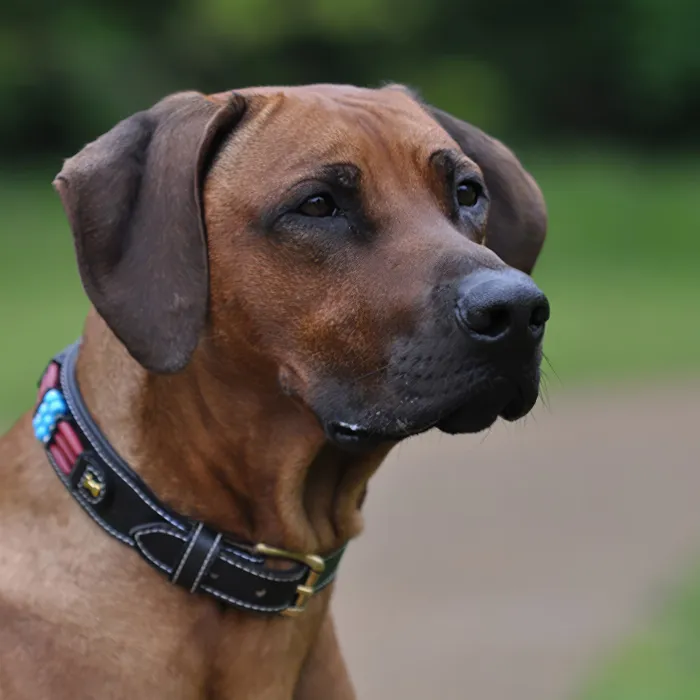Part 01 - Introduction: Animal motif - beastly good!
Part 02 - The right equipment
Part 03 - The main problems: light & sharpness
Part 04 - It's all about the detail!
Part 05 - Shooting preparations and planning
Part 06 - Dog photography
Part 07 - Cat photography
Part 08 - Horse photography
Part 09 - Small animal photography
Part 10 - Indoor shoots - studio photography
Part 11 - Outdoor shootings
Part 12 - Image editing
Part 13 - Various general tips
Part 14 - Reptile photography
Even as a child, I had a very special love for horses, like most girls. I didn't let go of this passion later on. A year ago, I fulfilled my lifelong dream of owning my own horse and of course I always go to a horse shoot full of enthusiasm. I always have to remind myself to use the camera and not just admire and stroke the person on four legs. For me, horses are like balm for the soul. Just being there is enough. Their scent, their warmth and their friendly nature manage to transport you to a whole new world. As you can see, I am completely captivated by these creatures. They are simply wonderful. But photographing horses is just the same. Unfortunately, many people are afraid of horses or don't like them or are relatively "neutral" towards them. I notice this again and again in everyday life, especially since I have a horse myself. If you like horses, then I hope that this tutorial will give you a few new ideas or information to help you take even more beautiful photos of these animals. If you don't like horses or are afraid of them, then it's high time you did something about it. In that case, I would like to "change your mind" a little with this tutorial. I would like to share my favorite quote from Kim Kösters:
"No words may ever describe this horse, for deep in his heart he will remain a horse of the gods. When the thunder rumbles in the night, the shadow horse wakes with a cry. Powerful, proud and beautiful, it gallops across the land, no one will ever get it in his hand ... If man has ever made a great conquest, it is that he has won the horse as a friend!"
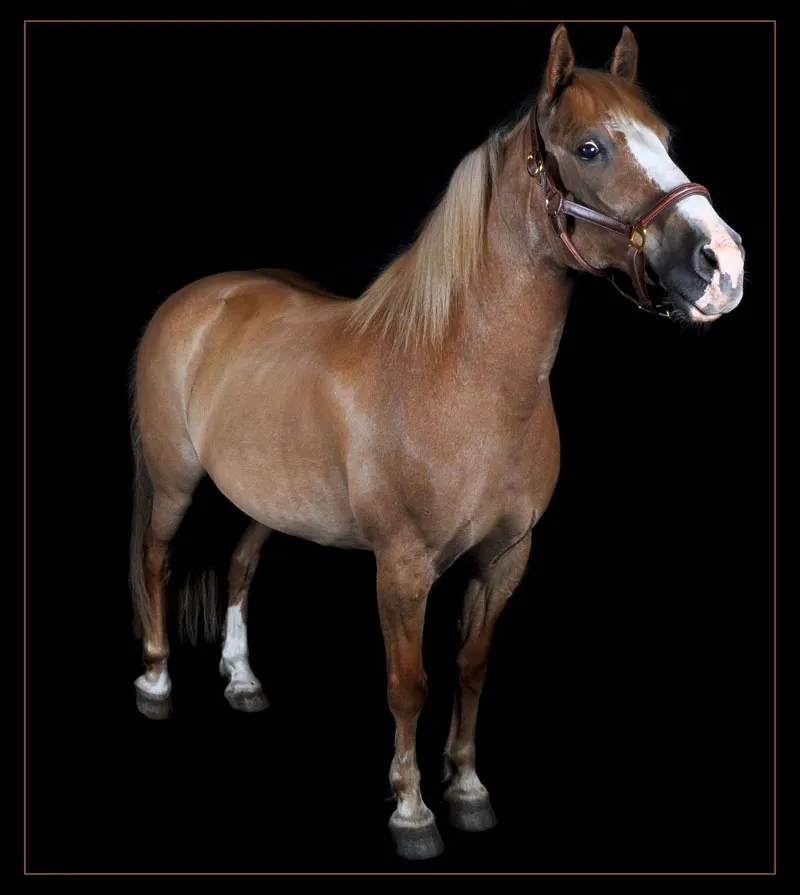
That's what real friends look like!
There are a lot of horse photographers out there, and often I can only marvel at the great pictures. I was very pleased to find a very well-known horse photographer here at PSD-Tutorials.de, the "Pferdeknipser". I have to take my hat off to him, because his photos are simply beautiful. He manages to capture the soul of the horse, to convey feelings and emotions. The horse comes alive in these pictures and that is exactly what the photographer should aim for. Will he always succeed? I certainly don't. But practice makes perfect, as has often been said before.
Please don't blame me, I'm assuming in this tutorial that you haven't had much to do with horses. I will pretend that you are an absolute "newbie" in the field of equine science. If you've grown up with horses and just need a tip on how to photograph your own horse, I hope you'll get something out of this tutorial, but I also want to encourage other amateur photographers to take a look at the horse as a very special subject and hopefully get stuck with it.
As already mentioned, the first thing I would like to do in this tutorial is to introduce you to the horse in its most beautiful form. As a good friend and soulmate, without forgetting what it is in its origins. An animal of flight. This is a very important fact for your work as a photographer and should not be forgotten. If you are afraid of horses, I would like to help you a little here too and give you tips on how you can work on this. I hope you enjoy reading this. As always, I hope to receive your suggestions and criticism, both positive and negative, and of course lots of horse photos, which you will soon be taking. May no horse in Germany be left without its own photographer!
The structure of this tutorial:
- Camera equipment/settings/equipment
- Horse subject. Up close and personal with the Hottehü
- Literature and breed studies
- Fear of horses and how you can overcome it
- Musculoskeletal system
- The horse at the shoot - instructions for photographer and animal owner
- The horse as a subject...
a. Exhibitions / Events
b. Equestrian sport
i. Western (rodeo / cattle drive)
ii. Dressage
iii. Jumping
iv. Gaited riding
v. Ground work
vi. Trotting/gallop racing
vii. Vaulting
viii. Carriage
ix. Other
c. Horses in free movement
d. Horses and humans - Horses correctly portioned.... Please in detail!
- Studio photography with the horse
- Voice of the horses
1. camera equipment/settings/equipment
Shamelessly, I would like to take this opportunity to refer you to three other tutorials in which I have already covered this topic in great detail:
-Part 2 - The right equipment
-Part 10 - Indoor shoots - Studio photography
-Part 11 - Outdoor shootings
In this tutorial you can read about camera settings and, above all, the equipment you need.
But what I would like to mention here is that almost all the shots here were taken with a Nikon D90 and a Sigma lens 70-200 mm (2.8). I always have a spare battery and memory cards with me on my "horse shoots". I usually take a lot of pictures here, especially as the horse is such a versatile model. Another piece of advice: always dress appropriately. Almost nowhere will you get as dirty as at a horse photo shoot. Well, it has the advantage, unlike with dogs, that you don't have to lie down on the ground to be at eye level. Although of course there are also small horses ... joking aside! However, you should wear sturdy and sturdy shoes, especially if you go out into the meadows to take photos or to the riding arena in rainy weather. In the wet and cold months, most meadows resemble a swamp. In very severe cases, rubber boots are also allowed.
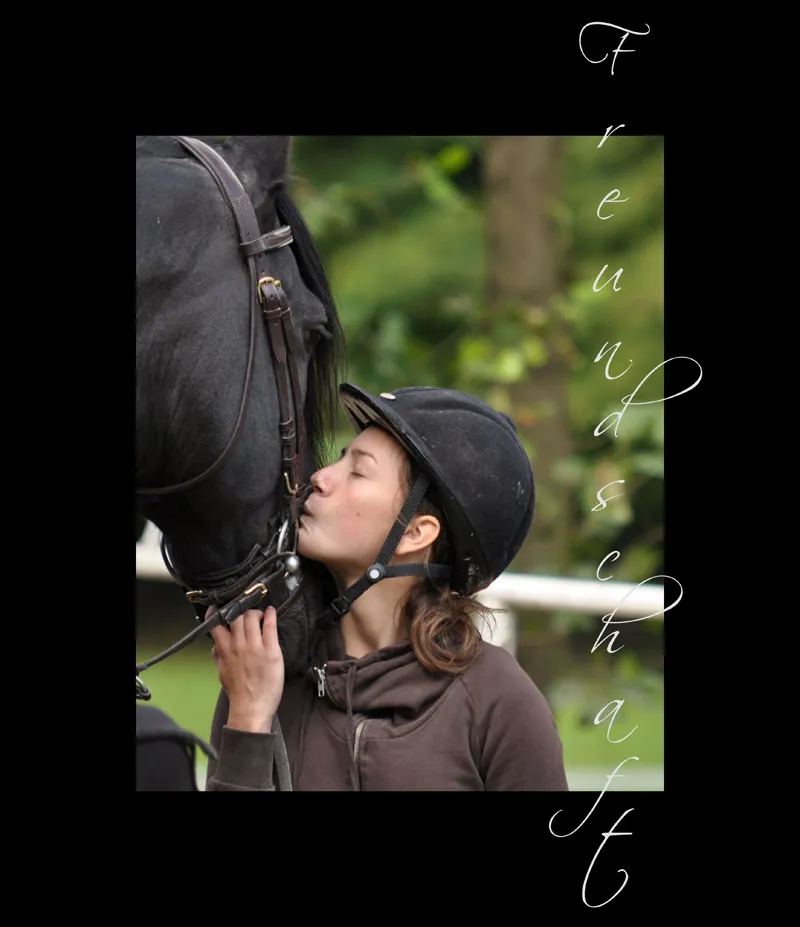
The two of them feel unobserved!
2nd horse motif. Up close and personal with the Hottehü
I've already written enough about how great horses are. If you haven't really dealt with these large four-legged creatures before, but would now like to make friends with the idea of using this motif for your pictures, then you should get to grips with it in the same way as with the other animals. Learn something about horses and how you should behave towards them. That may sound exaggerated, but let's be honest. If I - as a non-reptile expert - want to photograph a bearded dragon tomorrow, then I should also get to grips with it a little beforehand and know what to expect in advance. As you may not have a good friend who owns a horse, just as I don't have one who can tell me anything about his reptiles, why not fall back on two other sources of information: the Internet and literature. I would like to recommend a few internet links to you right now, but please refer to the next bullet point "Literature and Breeding".
Here is a list of useful links as a source of information on horses:
-Horse behavior: http://www.pferdewissen.ch
-Beautiful list of characters and breed characteristics: http://www.pferderassen-verzeichnis.de
One sentence that has stuck with almost everyone from childhood is: "Never walk behind a horse." True! I would also argue that almost everyone knows not to touch strange dogs without permission and never stare them in the eye or pet them without "introduction". Absolutely right. The same applies to cats: they can purr one minute and then extend their claws the next. Caution is advised. Many people have also made this acquaintance as a child. However, as this is certainly not enough to always handle horses safely, I would like to tell you a little more.
Over the years, I have witnessed many accidents myself and when I read the page by Bert Schöneich that I linked to above, I often had to smile. What it says is true. We often misunderstand horses! Dogs live in a pack and have a fixed hierarchy. Horses have to be treated very specially because they are considered flight animals and that is precisely the problem and the main cause of accidents, unless we have caused them ourselves. As I'm not writing a book about horses, but rather trying to give you something to take with you so that you can tackle horse photography and master it without making any major mistakes, I would therefore like to concentrate on points that are important to you. But you can't do that without getting to know the horse a little. So, let's make one thing clear: the horse is a flight animal and it has a clear body language that you should always pay attention to.

What does this mean for your work? Imagine the following scenario: You have a 600 kg warmblood horse standing in front of you in the studio. It reacts nervously to your presence and your equipment, eyes the lights critically and seems tense. The owner tries to calm it down. Everyone involved is tense, the horse starts to prance, its hindquarters move and suddenly it bumps one leg against the background pole or one of the lamps. It falls over and the horse is terrified. Now let's pause this scene. A dog would probably jump away and hide behind its mistress. A cat in such a situation would cut the photo cardboard into strips and jump into a dark corner. All harmless. And what does the horse do? It becomes a huge danger to itself and all living creatures around it, whether on four or two legs. Do you know how much power a 600 kg horse can develop in a panic? Do you think the animal still recognizes its own owner at this moment or takes it into consideration when this person is standing in the supposedly only escape route? No! The horse will jump, kick or run away in full panic and trample everything in its path. I don't want to scare you, quite the opposite. Because if you know how these animals react to certain things, you can minimize any risk and avoid possible damage.
A horse (except horses that have had bad experiences with people) will never kick at people for no reason. There are of course extremely fearful horses or horses that are very suspicious of strangers. We are first and foremost a predator for horses, and as a photographer you are probably even a particularly threatening predator. So if a horse is faced with a potential danger and cannot escape, regardless of whether the owner is holding it or it has no room to get out of the way, it will panic and may even make threatening gestures to show you that you should not approach any further. Only when the horse sees no other option will it possibly react with aggression.
You should therefore always approach everything with caution, do not make any hectic movements in the immediate vicinity of the horse, do not approach and touch it without being seen and try to avoid sudden noise. These are all typical triggers that can startle a horse and it may jump to one side or similar. Stupid if it destroys your equipment in the process, but even worse is the danger to humans and animals.
In order to see whether your horse is just calming down or is frozen in fright, you should know a little about the body language of these animals.
Excitement
If a horse is excited or agitated, it will stand upright, stand a little taller and open its eyes wide. Its nostrils may be flared, it may breathe loudly, its ears may be pricked up and it may put its tail down. In thoroughbred horses and stallions, this level of excitement is often an expression of their unique temperament, which is exactly what the photographer wants to capture. However, it can also be a sign of extreme excitement and tension; the horse has all its senses on alert and is ready to bolt at the slightest sign of danger.
Panic
If a horse is excited and is not "left alone" or is suddenly frightened or cannot react to the urgent instinct to flee, it will panic. You should therefore always leave an escape route. Especially in the studio. Never try to restrain a horse that is panicking. This is often the first thought. Forget it! Get to safety. You can't hold a horse in panic. However, as you can often already see signs of incipient panic, you should take them to heart and act immediately: Move the horse to a familiar environment without creating too much commotion or noise. In this case, the studio project should always be stopped immediately. Possible signs are similar to those of excitement: puffed out nostrils, anxiously opened eyes, uncontrolled movements (possibly stepping backwards or on the spot, the horse is trying to get away from something). The horse will try to somehow get away from the object that triggers such panic in him.
Threatening/aggressiveness
If a horse is afraid of something and feels constricted, it may start to threaten. As described, this is the last resort for an escape animal and is only used when it sees no other option. You will often see this type of behavior in a herd, but a normal horse will only use these methods in exceptional situations or not at all with a two-legged friend (perhaps at the vet or farrier ...). Pinned ears, for example, may be a signal of strong displeasure. Distinguish here whether the horse has only put its ears back because there is a noise behind it or whether they are clearly laid flat backwards against its head, a threatening gesture.
Relaxation/neutral body posture
In outdoor shots, our horses can of course be a little livelier and sometimes more spirited, but in the studio we should photograph horses that are as relaxed as possible. A relaxed horse will hold its head low, let its ears dangle a little and generally adopt a "hanging" posture.
ALWAYS take care when photographing a horse that has just been put out to pasture and is romping around. Horses that have been standing in the box for a long time and are now suddenly "let loose" and perhaps even driven to run for the photographer are not entirely harmless. It often happens that when I am standing in the middle of the meadow or crouching at the edge, the horse comes rushing towards me, then runs very close to me and kicks out backwards. You will agree that this is very dangerous. Horses don't deliberately run over people, but when they're running wild, they forget that people are very vulnerable. In any case, my heart has often stopped before. So take a little care of yourself. I'll give you a few more tips on this under "Horses in the meadow".
3. literature and breed history
As already mentioned, I would like to recommend a few books that will certainly help you to understand the horse a little better. As a photographer, you should not only deal with the horse's character and behavior, but also with the individual breeds and breed characteristics as well as the musculoskeletal system (see point 5) and the individual riding styles. After all, you need to know what draws the special features out of your subject or which movement should be captured (e.g. the crossing of the front legs when spinning in Western riding).
- Horse behavior: Body language and communication. Solving and avoiding problems - Barbara Schöning
- Body language: Horsewatching: The body language of the horse -
Desmond Morris - Horses - The new encyclopedia by Elwyn Hartley Edwards
- The big horse encyclopedia A-Z by Edel Marzinek-Späth
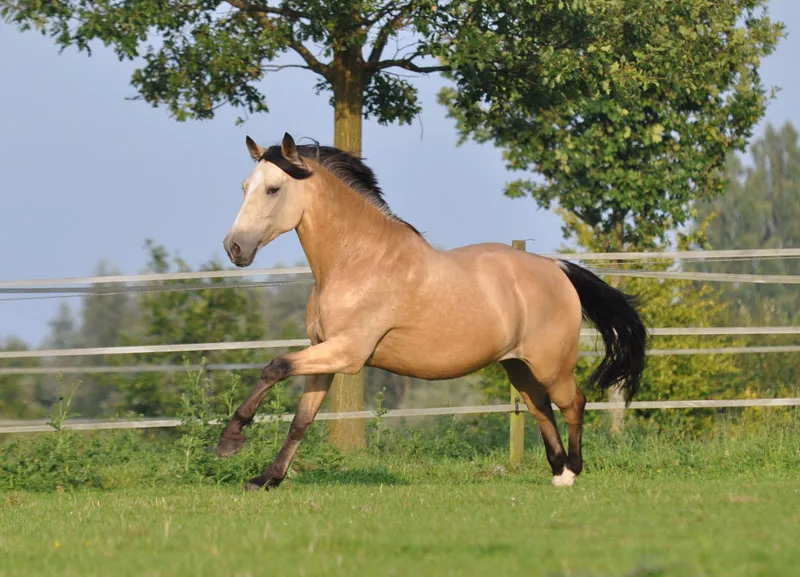
4. fear of horses and how you can overcome it
In the dog tutorial, I have already told you about my own fear, which I was able to overcome successfully through my work. My phobia of dogs has now changed to such an extent that even barking sheepdogs or threatening guard dogs no longer bother me. Three weeks ago, I ran up to a bull terrier without thinking about the above-mentioned rule "Never touch strange dogs". When the dog nuzzled my hand, I realized what I was doing. A few months ago, I would never have touched strange dogs if I could have avoided it!
So what triggered this change? Two things. Knowledge and contact. First of all, I now know a lot more about dogs and their behavior than I did back then, and I also meet new and completely unfamiliar dogs almost every week. Different breeds, different characters, and every one of them has a story to tell, and it's not always a good one. Some are fearful, some are aggressive towards strangers. So I'm in constant contact with dogs and I'm learning more and more how to deal with them. Knowledge is power! So if you know what body language it has and what dangers actually exist when working with a horse, you will also be better off. Based on the previous two bullet points, you should now know enough about your counterpart and your new motive horse. Now we come to the difficult part of the work. The contact.
As with all fears, we simply have to face up to them. And again and again. Don't get me wrong. If you have a well-founded fear of horses, then that's the way it is. And this tutorial won't change that. But if you are only afraid because you don't know horses, then give these wonderful animals the opportunity to do so. Get to grips with them. You don't have to take riding lessons, but perhaps you know someone who is involved with horses or has a foster horse, if not a horse of their own. Why don't you go with them and let them tell you a bit about it? I know it will work. I promise you.
But I would also like to give you an example here to confirm that it can work to overcome your fear by getting more and more involved with these animals. My mother is a role model when it comes to fear of horses. She is generally an anxious person and as I have a very large horse, she was not very happy about the fact that she would have to make friends with this monster. At first she hardly dared to touch the horse, and when I gave her treats she always dropped everything because she was afraid. She gradually lost her fear because I didn't take it into consideration and she kept coming along because she wanted to, of course. She has seen that horses are big, but by no means evil or dangerous. She now goes for walks with horses, strokes and grooms them and already affectionately calls our horse her "grandchild". Yes, she has even triumphantly taken a seat on the back of a horse or two. Isn't that great? I think it's remarkable and I'm really proud of her!
If none of this works for you and doesn't diminish your fear, then you should simply reduce yourself to photographing horses from a distance at first. That works, no problem. You can always photograph a horse in the arena or in the meadow behind the fence at events. You don't necessarily have to get close to the animal itself. However, as these animals can give you so much more, as you can marvel at time and again during handicap or therapy riding, you should still think about getting closer.
5. musculoskeletal system
The horse's locomotor system is very complex. The horse has several gaits. These are normally walk, trot and canter. With some gaited horses there are others. There are also very specific dressage movements that you may need to capture on camera. You should be familiar with these movements and be able to capture them at the right moment.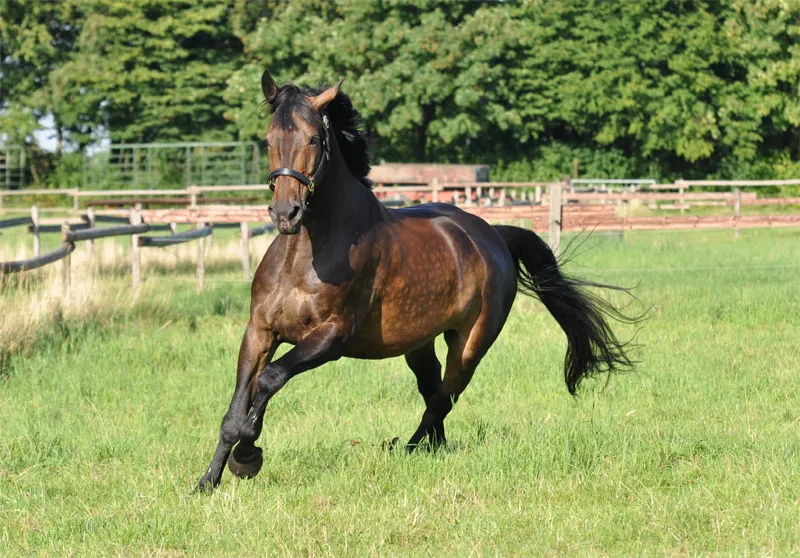
This horse gallops across the meadow. It is best to observe and photograph a horse in motion and analyze the individual activities of these animals captured in the picture. Look at a few pictures. Be creative. For example, enter "western riding" in the image search on Google and you are sure to find some "action pictures", e.g. of the stop.
6. the horse at the shoot - instructions for photographer and animal owner
Preparation for the shoot: If you are to take photos of the animal in motion, the horse should not be given any concentrated feed for about 1.5 hours. The owner will probably know this, but a hint certainly can't hurt. The animal should be healthy, not freshly vaccinated and, above all, well groomed. This can take a little longer ... There are certain shine sprays; it is important to note that riding bareback can turn into a slippery ride. In addition, some sprays can leave dark spots in the coat, which may be visible in the pictures.
When you introduce yourself to the horse, approach it slowly and hold out the back of your hand so that it can sniff you. If the horse allows this, you can stroke it gently. If the owner allows it, you can of course also give it a treat.
As already mentioned, you should always proceed with caution when working with the horse and not ignore its tendency as a flight animal. Talk to the animal owner in detail beforehand. Ask him about possible fears of the horse, ask him about character traits (courageous, spirited, fearful ...) and what you should avoid at all costs. Below I give some suggestions on how you can photograph the horse and how you can possibly involve the owner. Here you will find some more detailed information that you can pass on to the owner so that he knows what to do and how he can contribute to the success of the shoot.
7 The horse as a subject ...
You already know that the horse is a very versatile subject for the photographer, but how extensive? I have collected some pictures to illustrate this once again. You will also find some suggestions on how to photograph a horse well and show you the right way to approach the subject. This doesn't mean that you can't do much better! But an inspiration in the right direction can't hurt.
a. Exhibitions/events
Every year, especially in the summer months, there are exhibitions and events on the subject of horses. Depending on your level of enthusiasm, you may already be aware of this and perhaps travel regularly to such sensations. With or without a camera. Here, for example, are a few of the best-known horse fairs, where there is certainly a lot to see: http://www.reiter-pferde-messen.de/
b. Equestrian sport
There is a huge amount to see all year round when it comes to equestrian sport. That's why I've organized this into different categories. As I have not yet been able to photograph everything myself, I have only been able to bring pictures of a few things to show you here. As far as I know, there are regional magazines that contain tournament schedules. Otherwise just ask at a riding club in your area or visit the homepages of the riding stables. There are always dates for the next year in advance. You should be able to find what you are looking for. Just drop by as a visitor, there's no better way to practise and, above all, learn!
i. Western
Western riding is incredibly versatile. In addition to the many western shows, which are a highlight for photographers simply because of the great outfits of horse and rider, you can also visit a rodeo or a cutting (working with cattle). Look up the word western riding on Wikipedia. You will be surprised what you can find there.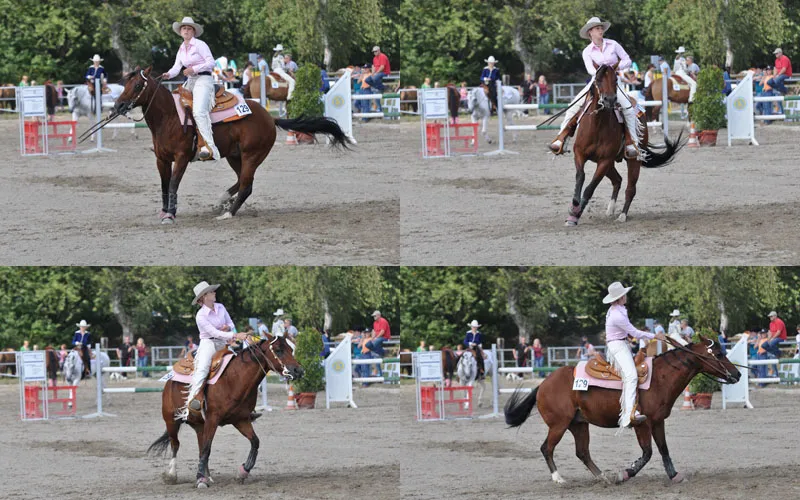
Captured step by step - the turn in western riding!
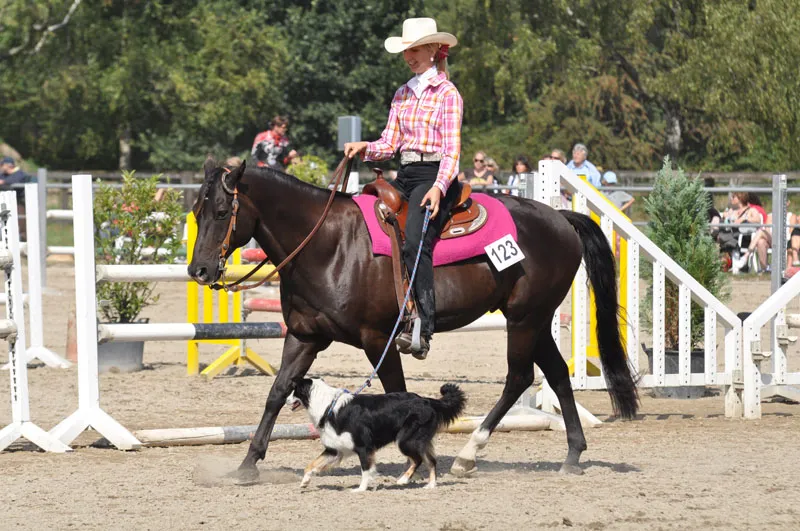
Dog trail - horse and dog follow the rider through a trail course.
ii. Dressage
Classic English dressage is also wonderful to capture in pictures. Just as with Western riding, you should of course know a little about the different figures and movements of the individual riding tasks in order to be able to photograph them to advantage.
iii. Jumping
I have not yet been able to accompany a real show jumping competition with my camera. Only the odd leisure rider or "fun jumper" has been there. It is a challenge to catch the horse flying over the obstacle at exactly the right moment. The best way to do this is to position yourself at the side of a jumping arena and choose 2 or 3 jumps that you have the best view of from there. If you are outdoors, make sure that you are facing the sun. It is also important that you know from which side the jump is approached so that you can photograph the horse from the front or slightly sideways from the front over the jump. It will certainly take a few shots until you get it right.
iv. Gaited riding
As my girlfriend owns a gaited horse, I naturally attend a gaited horse show from time to time. I was also able to photograph a lot of gaited horses at our local amateur sports festival. Whether Icelandic or Paso Peruano, the tölt is a great thing to photograph. Horse and rider usually radiate an incredible joy and satisfaction, which is probably due to the incredibly comfortable riding style; it is always a pleasure to accompany a gaited horse show. Incidentally, it's a great sight to see a rider and horse in traditional Peruvian dress.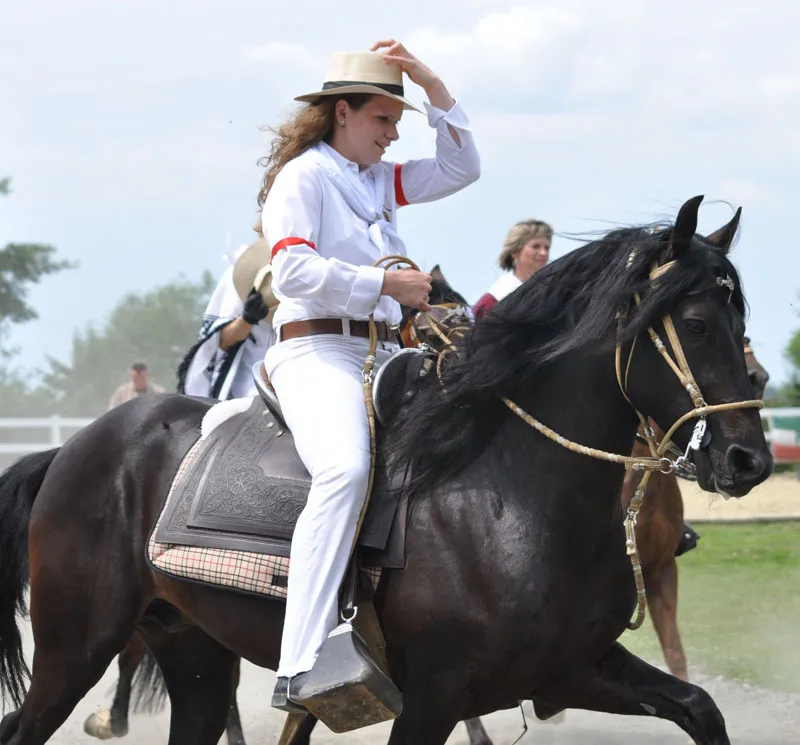
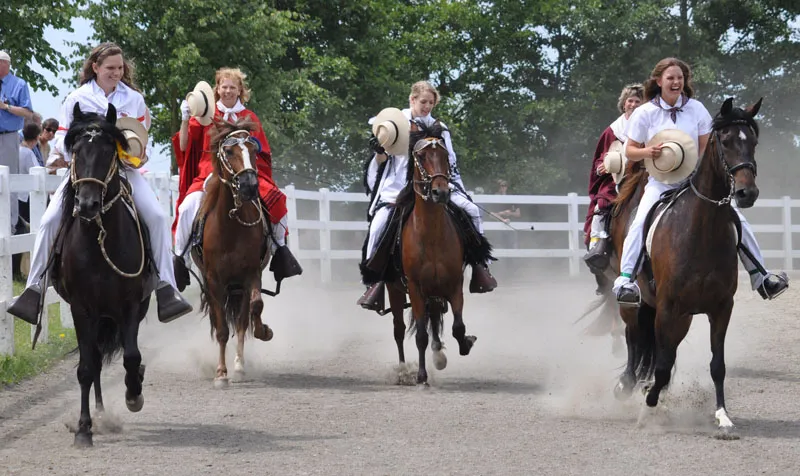
v. Ground work
Working on the ground, whether natural horsemanship or work on the lunge line, can also be accompanied by the camera. Here, too, there are often courses at large riding stables or riding clubs where you can certainly take photos in return for a few free photo CDs. Of course, attending such courses usually costs money for the spectators, but why not just ask? Well-known trainers often travel all over Germany to teach horse owners their way of working with horses, such as Peter Pfister, Uwe Jourdain, Michael Geitner, Bea Borelle, Sabine Lang, Silke Vallentin, Steve Halfpenny and many more. You can certainly take lots of great photos here, e.g. of a horse-and-dog trail or some circus lessons.
Here are some of the trainers' websites:
www.peterpfister.de/
www.zirkuslektionen-jourdain.de
www.bea-borelle.de/
vi. Trotting/gallop racing/polo sport
Unfortunately, I haven't been able to see all three of these things in person yet; certainly a great thing to be able to attend with a camera. So unfortunately I can't say much about it. Many large cities have their own racecourse, for example Düsseldorf and Neuss in our region. Races are held here regularly. You're sure to get the right goosebumps feeling right away!
vii. Vaulting
I am always amazed by this sensational work on horseback. Vaulting is an art in itself, and when you watch the ease with which the young women or girls "swing" themselves onto a horse that is a good 1.70 m tall, you probably ask yourself: How does that work? In any case, it is pure harmony between man and animal and it is a joy to watch! There are many vaulting clubs; just ask your local vaulting club if you can come to a rehearsal or the next performance. You will certainly receive a cordial invitation in return for a free photo CD..webp?tutkfid=63776)
viii. Carriage
I'm very lucky that a stable friend is actively involved in driving and always "takes me along" when she goes out with her carriage. That's why I've already been able to take one or two beautiful photos. Whether it's an old traditional stagecoach or a large four-in-hand, you're sure to be thrilled as a photographer and will hardly be able to put your camera down. I'll let the pictures speak for themselves.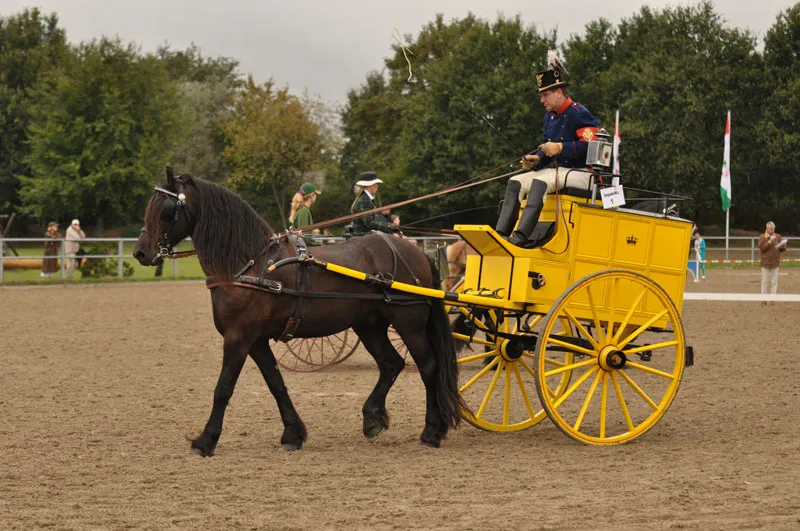
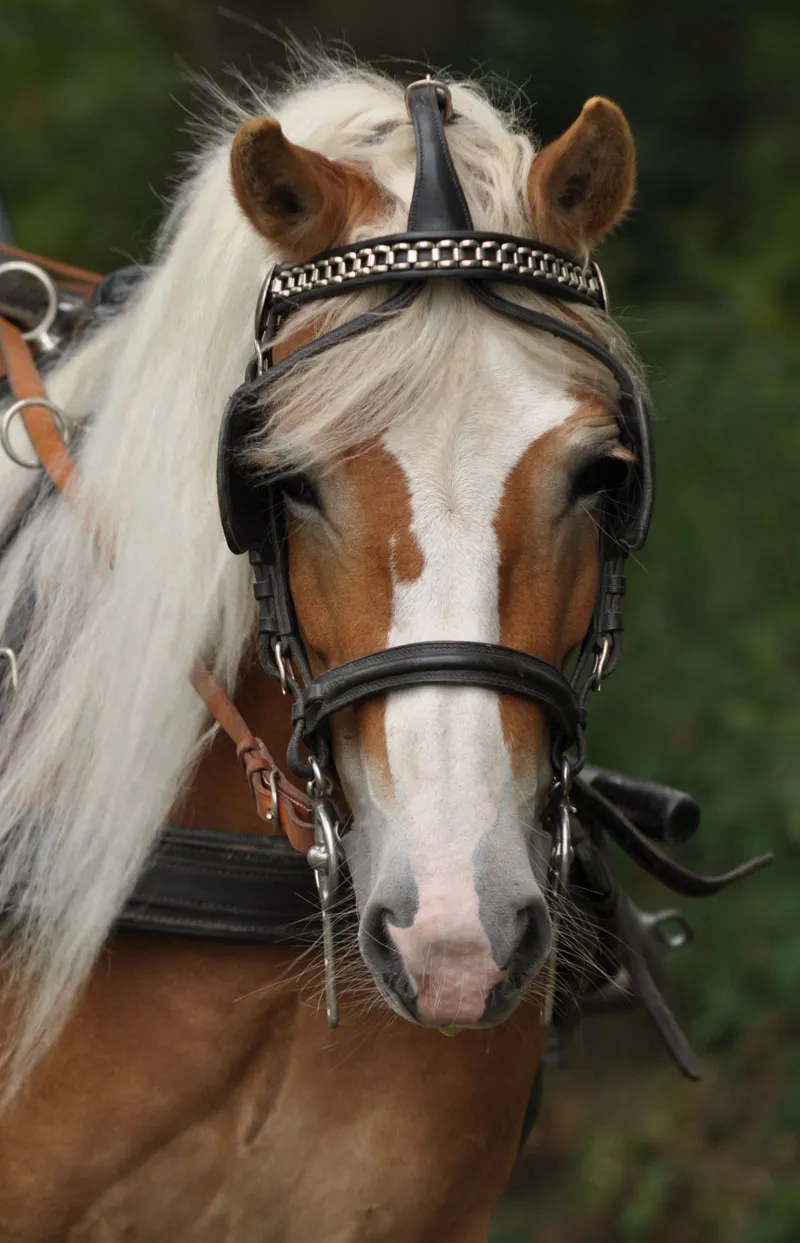
ix. Miscellaneous
I was able to take some nice pictures for the tutorial at this year's Breitensportfestival. It was perfectly situated to emphasize the breadth of the "work" with the horse once again.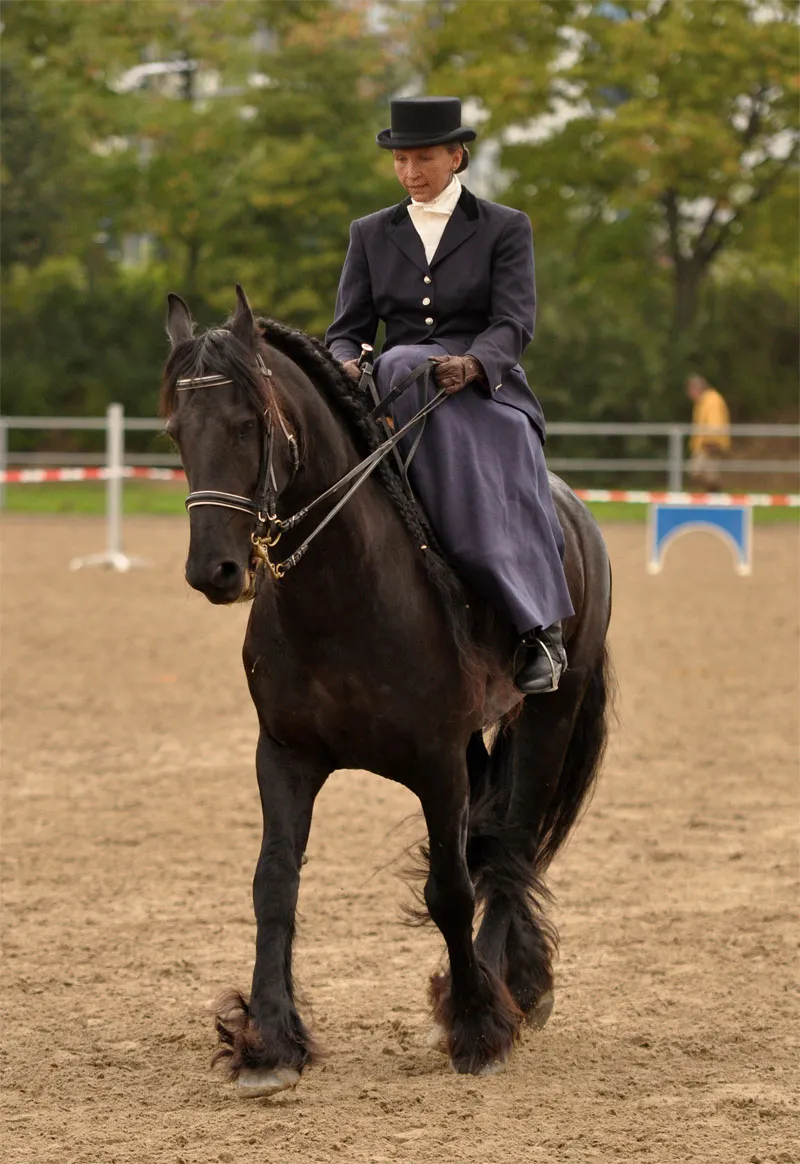
Riding side saddle
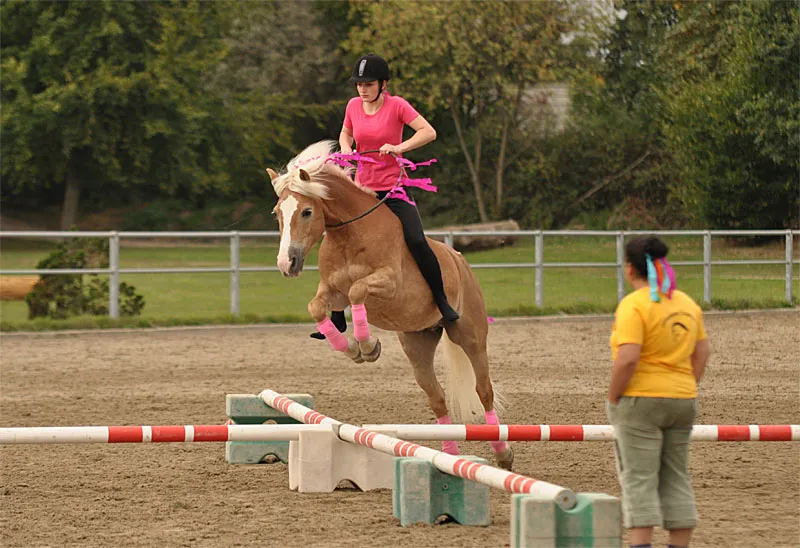
Show riding! Of course there is much, much more! This is just a rough sketch of everything that is possible. I still have a few things on my wish list. There are dressage quadrilles, which are very interesting, as well as a cross-country race (excerpt from the military) and a real hunt. There is also no limit to the variety in the show area. Because so many people love horses, we are lucky to have such a variety of horse-related events.
c. Horses in the meadow
Horses grazing are of course nice, but not really what you have in mind as a photographer. Therefore: If we want to photograph a horse in the meadow, then it can be a bit of action. As already mentioned, it's not always completely safe. I myself am one of those people who say: Nothing will happen to me, a horse will never run over a person. That's true, but a horse that has been in the box for maybe 1 or 2 days can really "freak out" when it suddenly comes out into the meadow. Very tense or boisterous horses can easily endanger themselves if they suddenly run out into the paddock and start charging and bucking ... As with us, it's no different with horses - it's no good without a warm-up phase. So you should always make sure that you don't overdo it. If the horse is a little calmer and needs to be encouraged to do a little "action", then please do everything in moderation and, above all, not without warming it up. So either go for a 10-minute walk first or let the horse walk a little in the arena beforehand. It still shouldn't gallop across the meadow for 10 minutes, but a little exercise won't do it any more harm than a cold start. It is usually enough for the owner to clap his hands a little or start walking to encourage the horse, sometimes a whip can also bring a little life into the horse. Of course, the horse is not touched. The owner should decide what is okay for his horse and how much he can stimulate the horse. It is perfectly sufficient for the horse to run 2 to 3 rounds across the meadow. That's all it should be.
I'd like to tell you about a shoot I had in Münster. The horses were only outside for hours at a time (it was also a very hot time of year) and the meadows we used for our shoot were very small. So there wasn't much room for the horse to run and for us to get out of the way. I bravely stood in the middle of the meadow with all the horses and they regularly came galloping in my direction (very close!), ran past me and then lunged backwards. There was certainly always 2 meters of space, but that can also backfire! In any case, I felt a little queasy! Then there was a situation that was really very dangerous. In the afternoon, a horse was led into a meadow that was very poorly lit. In order to take really good photos, I had to get into the tall grass, right next to the fence. As it turned out, this was very unfavorable, as the horse was always running along there and bucking. The horse knew I was sitting there, and yet it suddenly ran even faster and closer to me. I shot up to escape, the horse was frightened and we both didn't know whether to jump left or right. If we had jumped in the same direction, the handsome Norwegian would definitely have buried me under him. He was in full gallop. Horses can take a wrong turn, but this was really dicey. Luckily, I jumped to the right and the horse jumped to the left. I'm not afraid of horses, I'm not afraid of a herd galloping towards me, but since that day I know that something can still happen, and it was my own fault! The horse had probably completely forgotten about me and only discovered me in the tall grass when I bolted. Because he looked just as confused as I did, believe me! Horses often kick backwards in play, which can go well a thousand times, but once they miss. Every rider knows and has heard of such accidents. So be a little careful. You don't have to go into the meadow, you can take just as beautiful photos at a safe distance from the animal.
So let's summarize once again: It's best to either stand outside the fence and take photos from there. This requires a sufficient range for your lens and the meadow must not be too large. Or you stand in the middle of the meadow, the edge is unfavorable, as the horse usually chooses this path to run here. It can't hurt if the horse owner stands next to you with a whip and waves it when the horse runs in your direction. The horse will keep a little more distance here.
An ideal position to photograph the horse is either from the side or walking towards you at an angle. Of course, it can also be a great subject if you catch it running towards you from the front. If the horse jumps around and bucks, just hold it! Make sure you use the right focal length and always be flexible. If you suspect that the horse is about to mount or jump, then choose a smaller focal length so that nothing jumps out of the picture. If it is galloping steadily, then get nice and close. Or simply zoom in on the horse's head and photograph the flying manes! It doesn't always have to be the whole horse.
You can get more tips in the outdoor shots tutorial!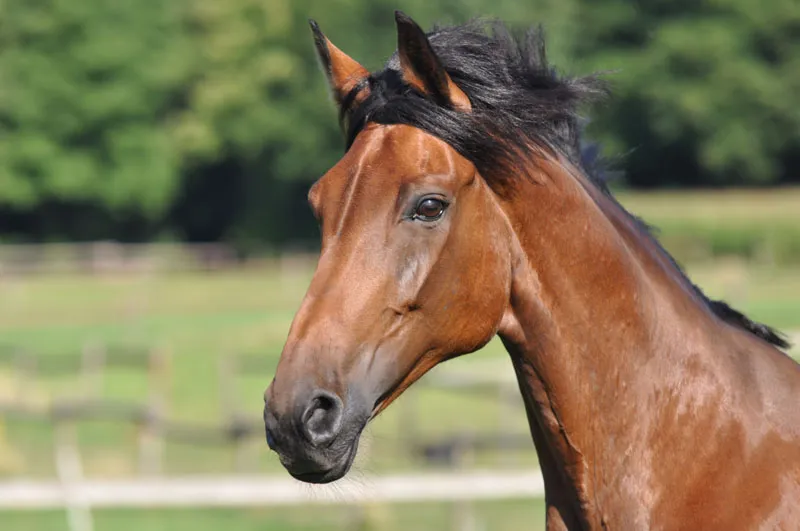
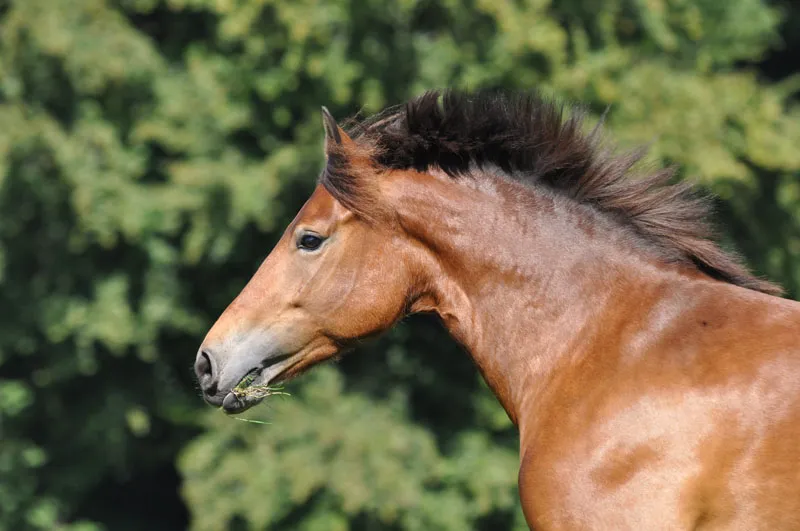
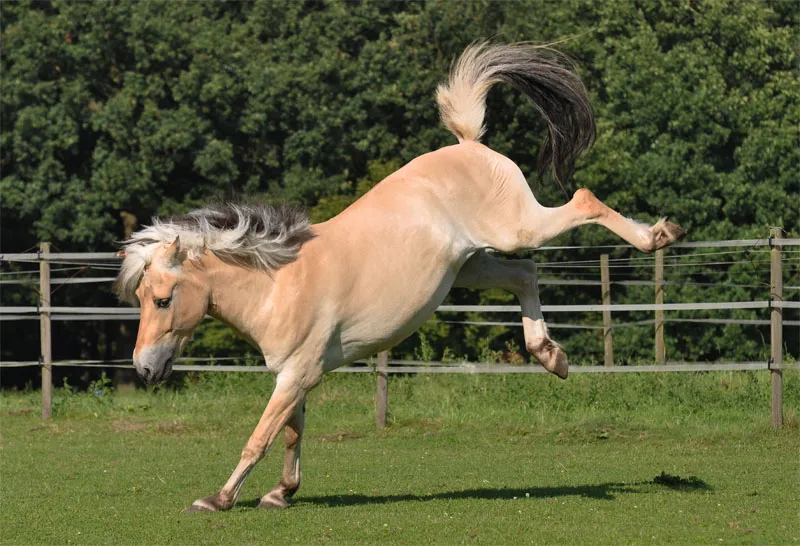
d. Horse and human
I actually only photograph animals, but now I'm having more and more fun photographing people and animals. Capturing the harmony and love between them is fantastic. But here, too, I prefer to let the pictures speak for themselves. It is important that the heads are not too far apart. I would also like to use the photos to give you some inspiration as to how you can position the horse and people. Otherwise, hold on to it when both don't notice, that's always the perfect moment!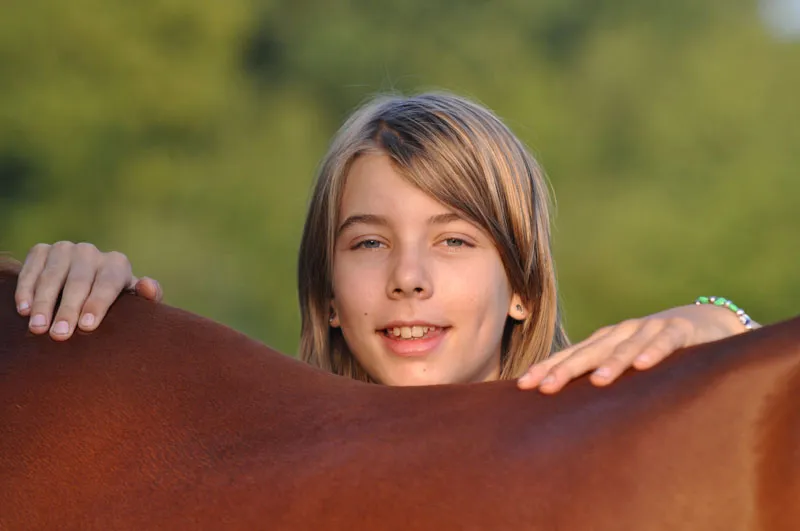
Over the back - always a nice position if the proportions are right!
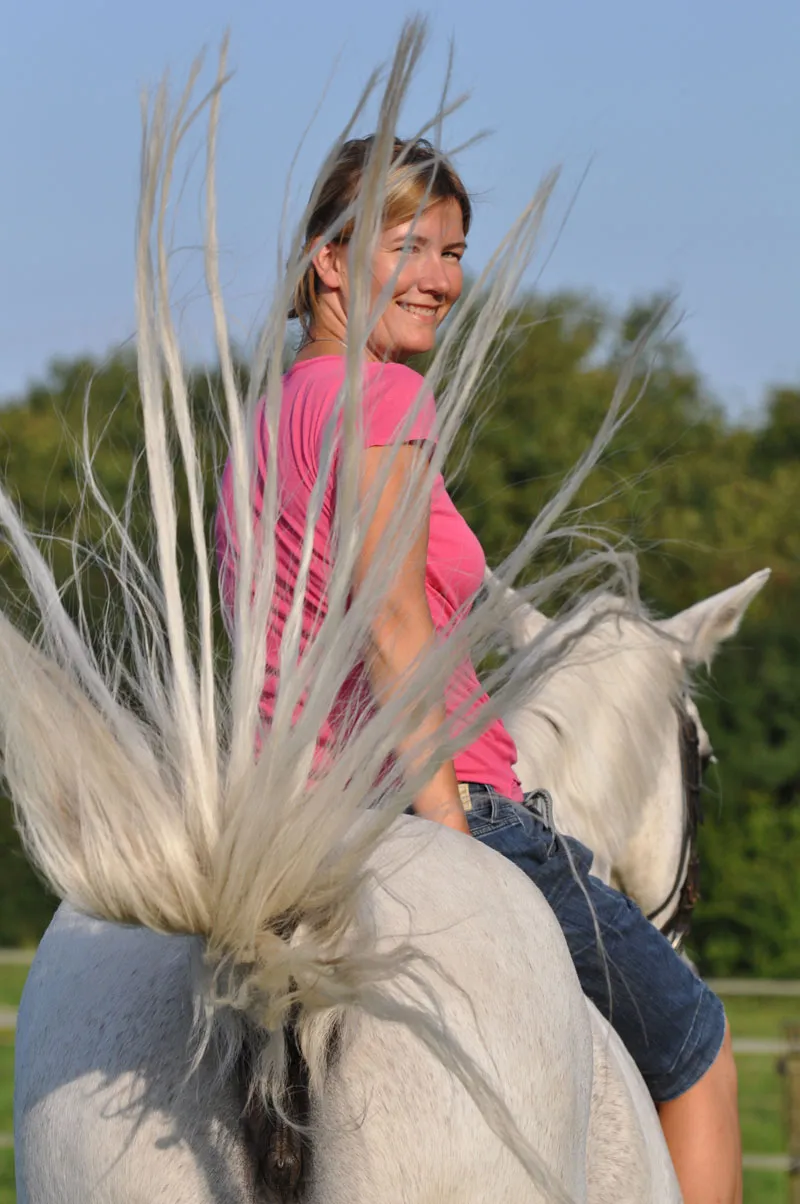
Admittedly, a snapshot. But generally a nice position to take a photo even without the tail.
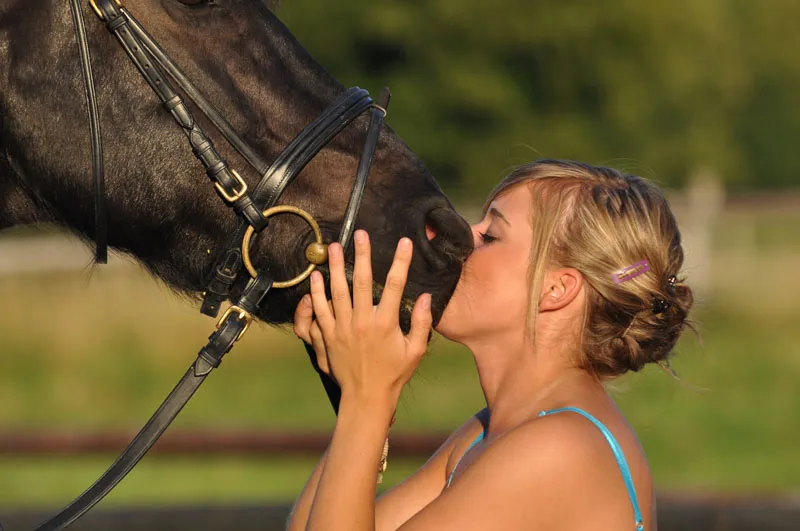
Beautiful! I hope the Friesian Vertigo will forgive me for this detail!
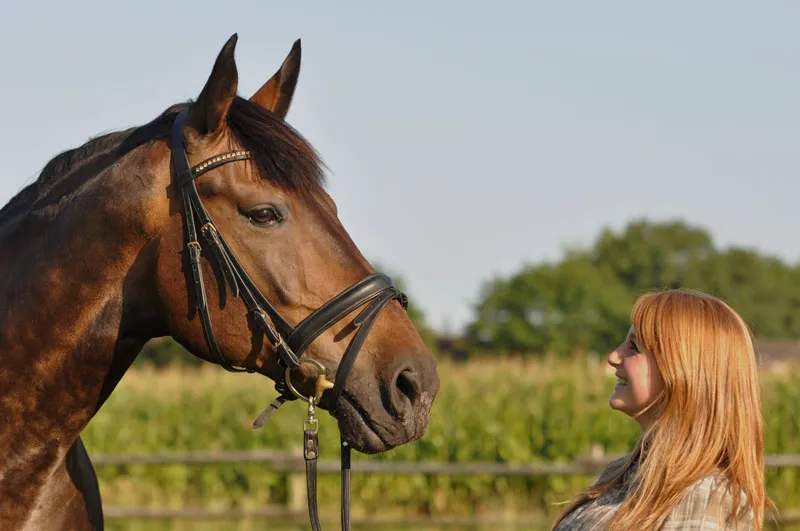
The juxtaposition!
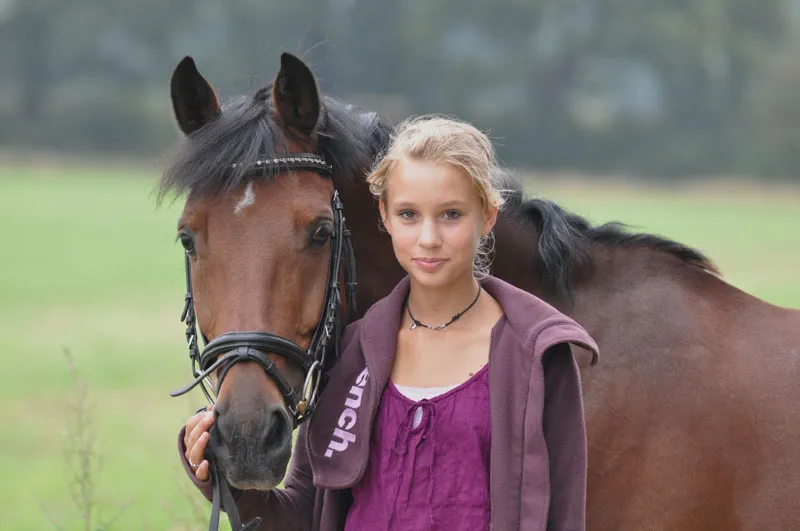
Classic position - both models next to each other (sideways)
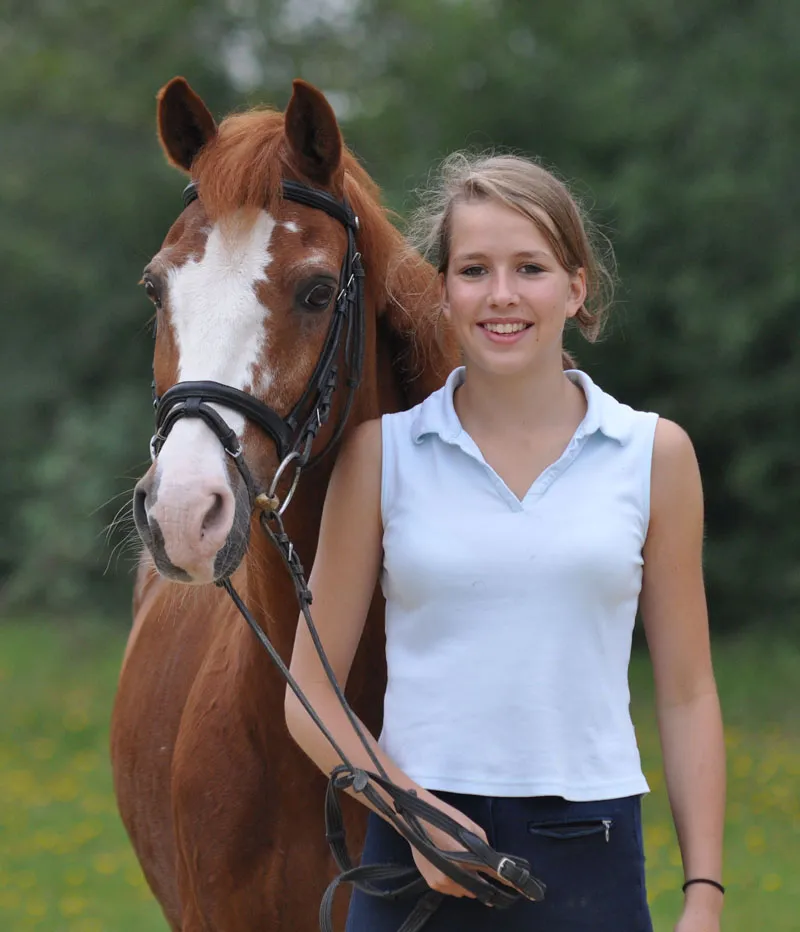
And again from the front.
Of course, a few edits can't hurt either!
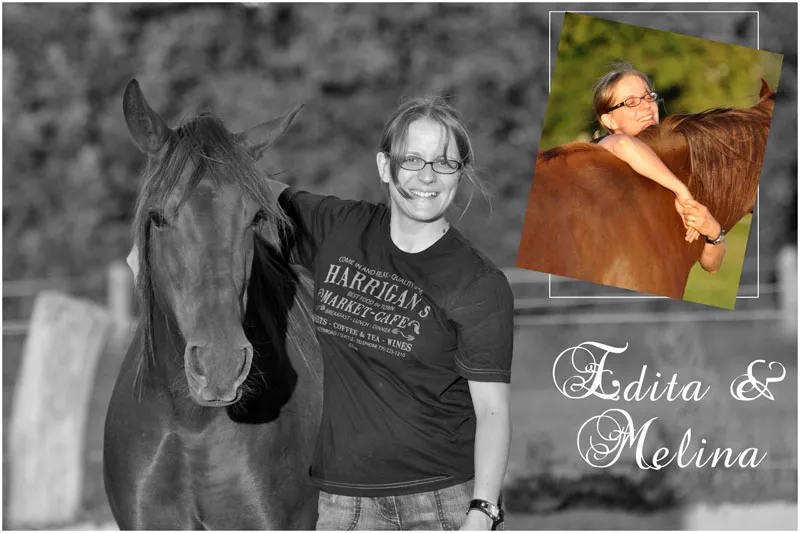
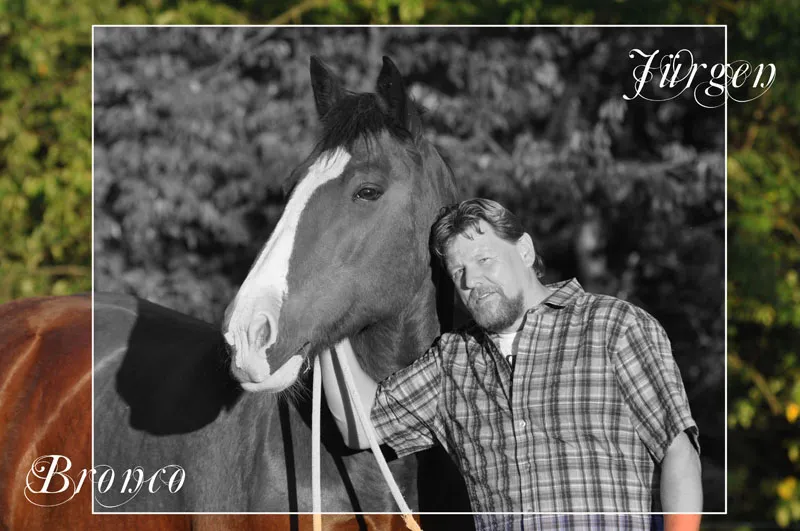
8. horses properly portioned ... in detail please!
I am a lover of detail shots and cropped photographs. I am regularly criticized for this. There are many people who say that nothing should be cropped from animals. Even my partner criticizes me for this and pictures that elicit a WOW from me are just: "Great, eyes. So what?" You don't have to do it if you don't like it. But I'm always encouraged by shooting clients who say: I really want photos of the eye or just the horse's nostrils. One customer saw a photo of a horse's legs in motion on my website and also wanted photos like that ... Tastes differ. I love detail shots. So if you are also a fan of such shots, here are some tips and inspiration. Many photographers also crop the forehead of humans, so why not try something similar with animals? I think it works.
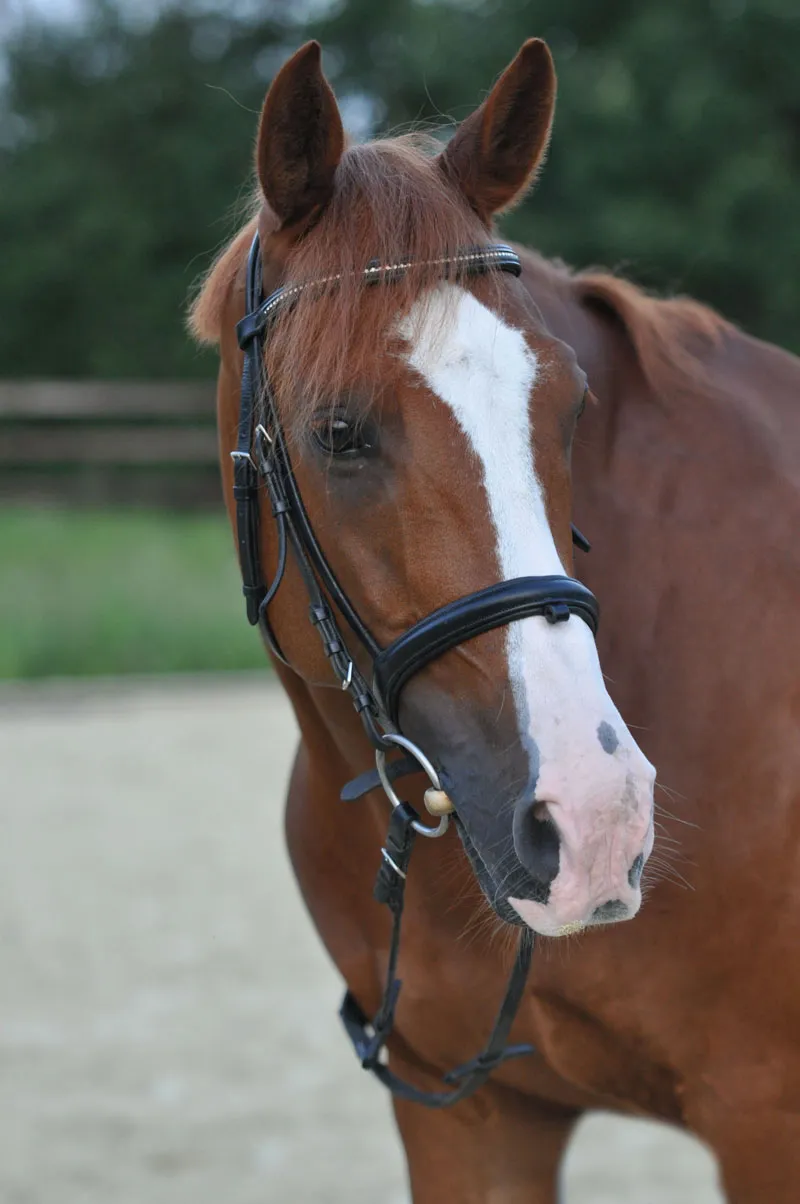
Portrait of Dancer
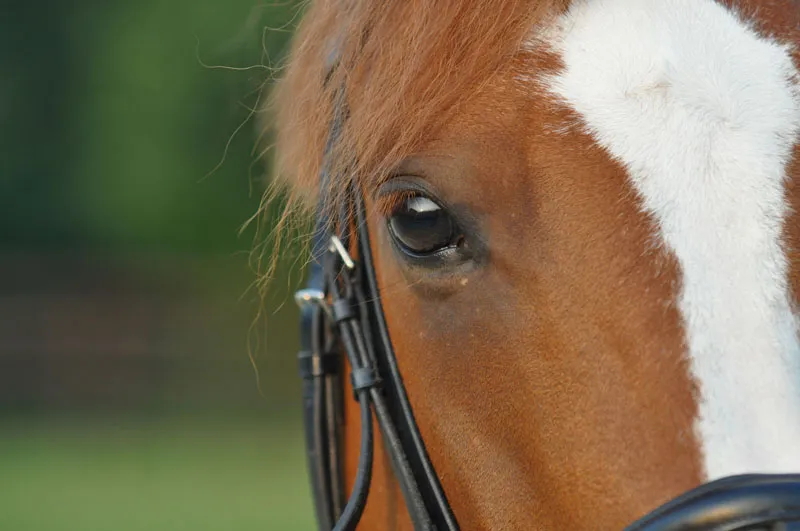
Dancer in detail - eye detail
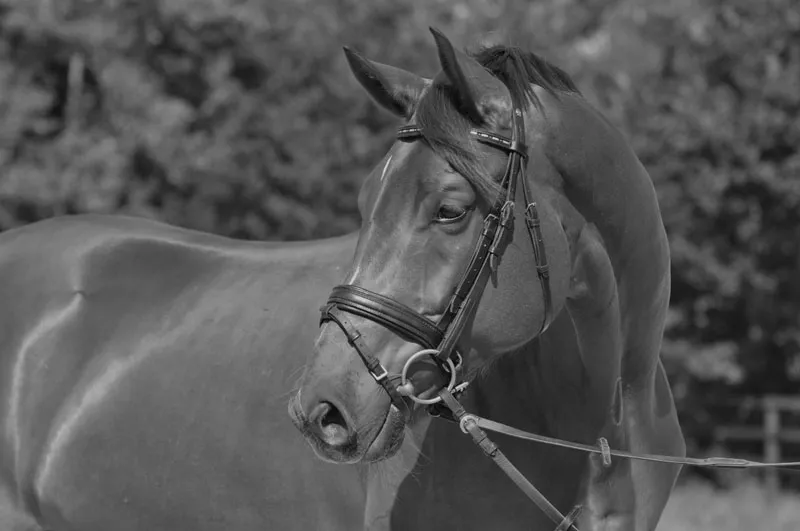
Another angle. Not uninteresting either. If the horse doesn't want to turn its head itself, a helper can help with a treat.
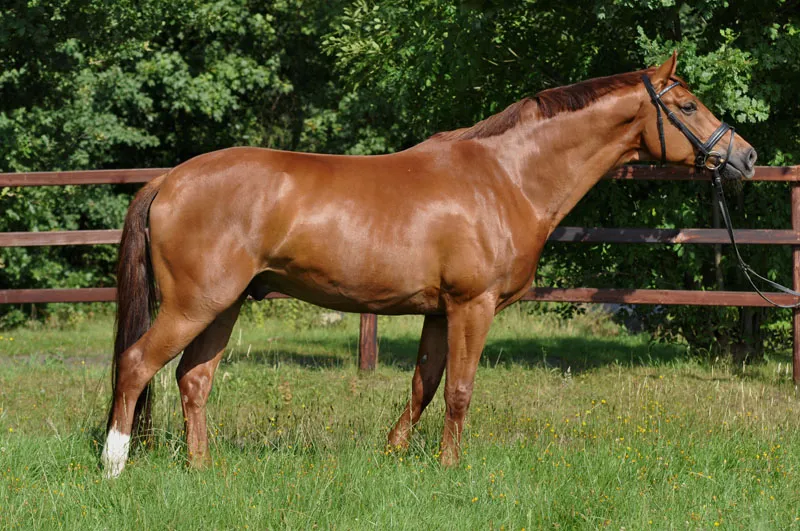
And the classic side view! Exterior
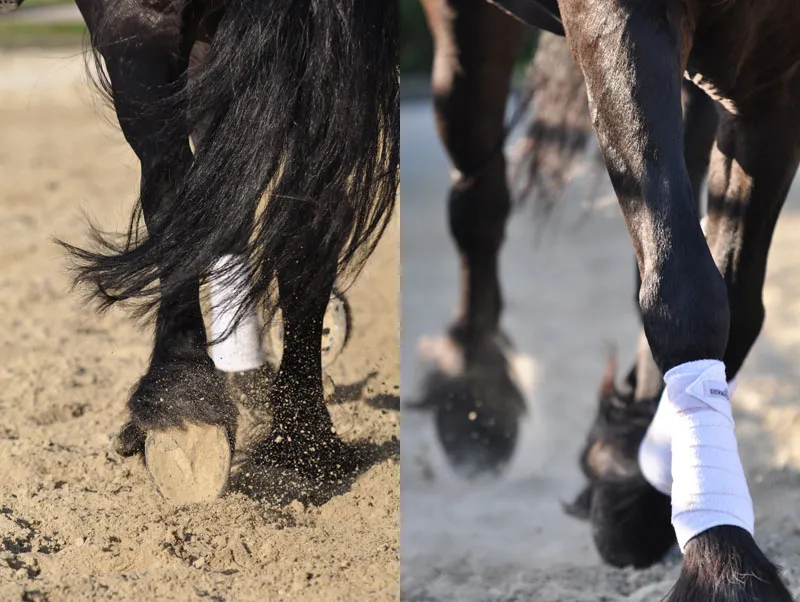
Close-up of legs
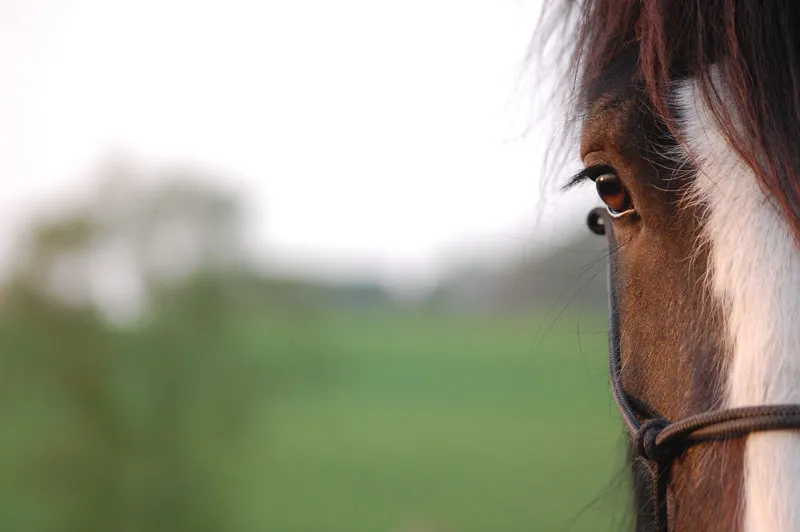
Eyes again. This time my Shire Horse Jonathan in detail
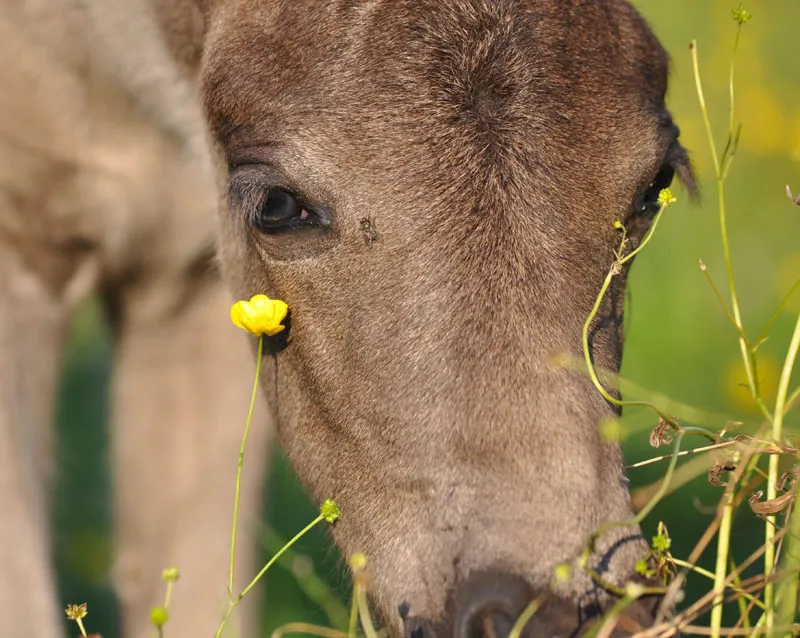
Detail of foal Mina's head
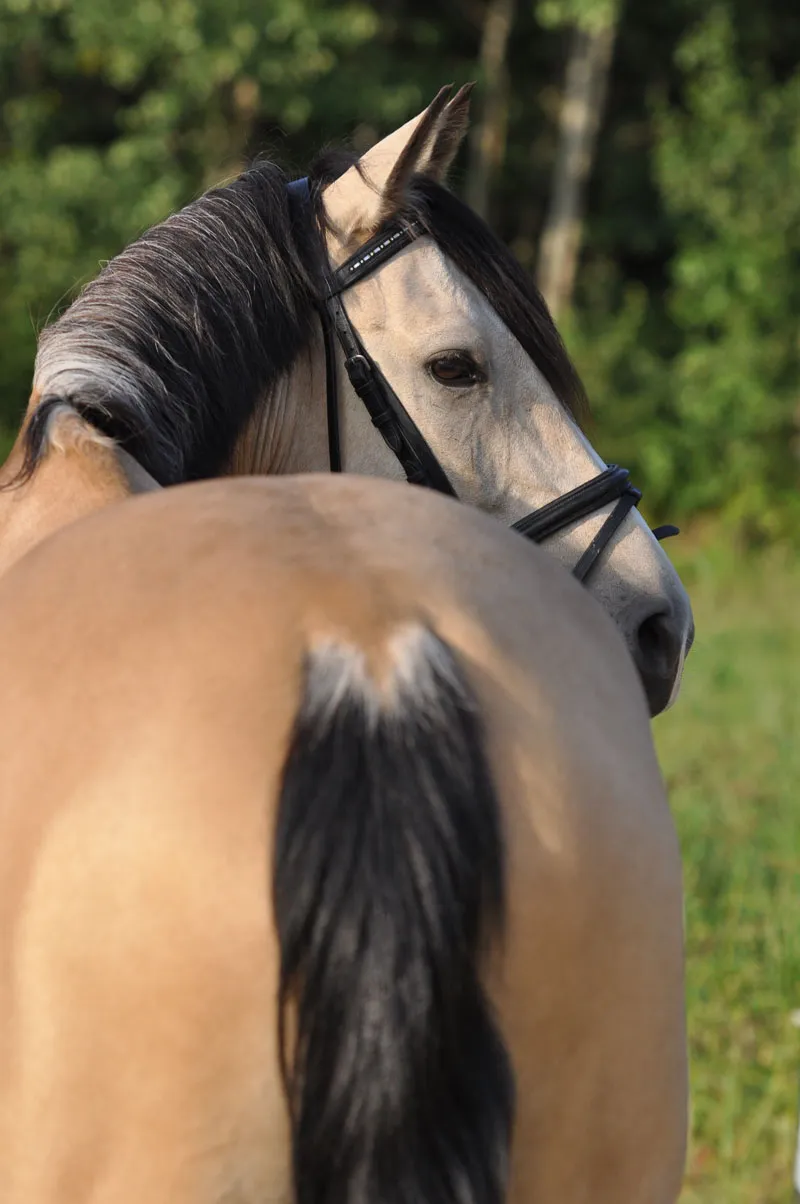
Handsome Baloo holds his backside up to the camera. An interesting perspective!
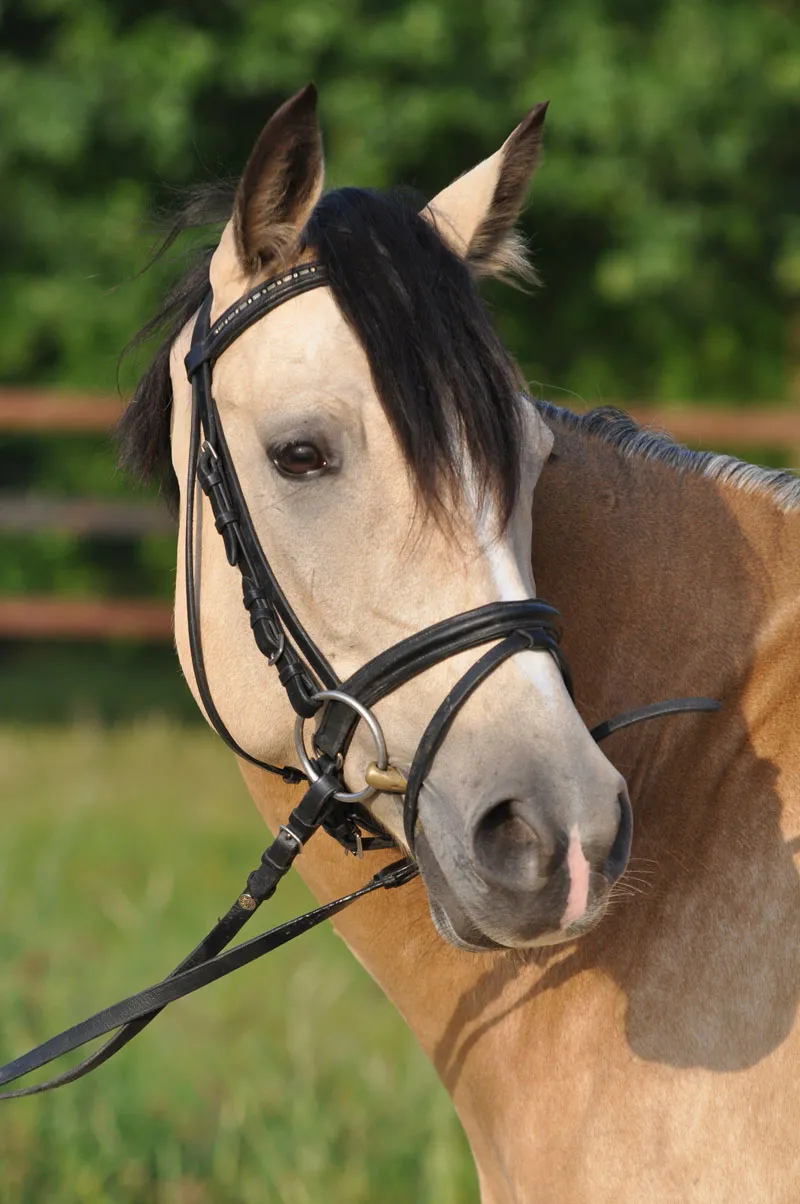
Baloo is incredibly photogenic. It was pure joy to photograph him.
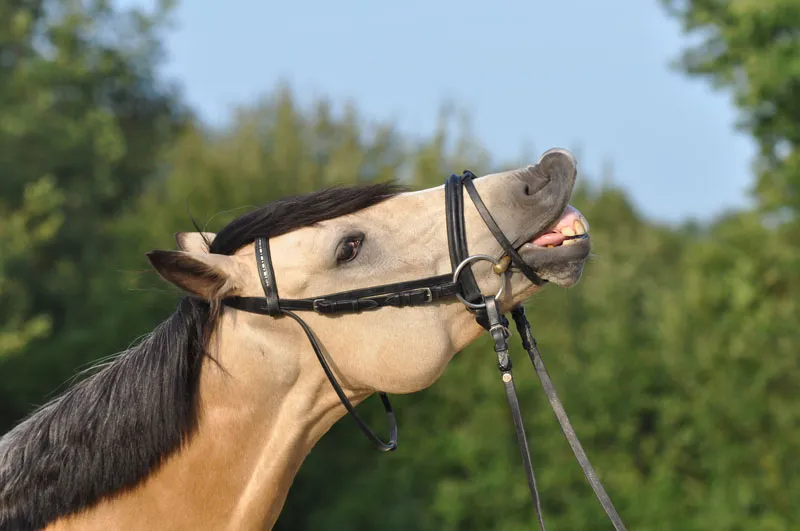
He can laugh too!
Two horses? No problem either. Just remember the distance-focus problem and the right Blender!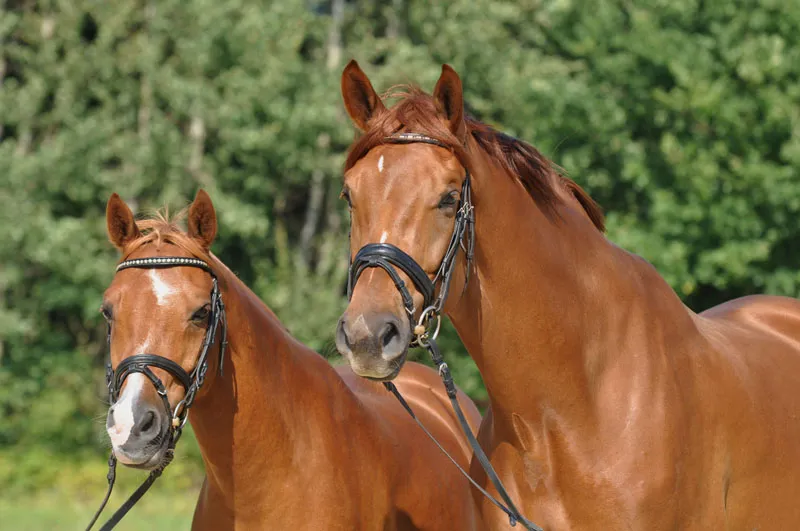
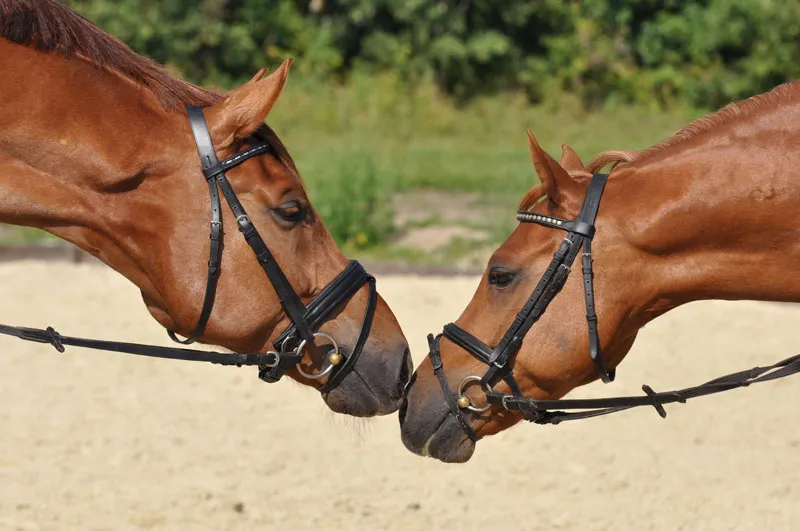
9. studio photography with the horse
The equipment: I usually use two studio lamps with softboxes. One is positioned in front of the horse and the other to the side of the subject. Ideally, the horse should be able to run through the middle without any cables or similar getting in the way if it suddenly gets scared. For the background, it is best to use the largest possible photographic fabric. 3 x 3 m, 3 x 4 m, 3 x 5 m. The larger the fabric, the better. The horse can then stand further away from it without its ears or similar protruding from the background. If you want to photograph the entire horse (not just the head) and possibly also cover the ground with fabric, you won't be able to avoid a 4 m length. I use a special photo fabric that absorbs a lot of light and therefore appears evenly black (e.g. 300 g). What is left over is edited with Photoshop. However, you can also place the horse in front of the black background in daylight without lamps. I have already done this. It is much easier to blacken the background than if you have photographed the horse in the meadow. However, the animal is naturally illuminated. However, disturbing shadows may appear if the horse turns its head to the side.
If possible, the owner should stand in front of the animal, but you still need room for an escape route! Always bear this in mind. In case of doubt, the horse will not run backwards first. If the horse is relaxed, you should make sure that you get the ears and an alert expression. Many horses tend to hang their heads and their ears at the same time. Some simply fold their ears back. Very bad conditions for a photo model. It is therefore important to arouse enough interest so that the horse looks at the photographer and pricks up its ears. It is best to have a helper behind or next to you, rustling a feed box or plastic bag. Of course, you shouldn't overdo it; the horse should still be relaxed, but attentive. Some horses require a lot of ingenuity before they prick up their ears and become interested. So you will have a lot of ideas over time. Horses walking past (at an appropriate distance, of course) are very advantageous. The horse almost always looks in this direction and pricks up its ears. Of course, it is just as disadvantageous if there is a busy stable aisle behind the horse. The horse will therefore always look in this direction ...
As already mentioned several times, taking a photo of a horse in the studio can be easier than you might think. I often experience astonished animal owners who are completely fascinated that their own horse reacts completely calmly to the black background, the lamps and the flash. I've never had a horse that couldn't be photographed in the studio, except mine! All of them have coped with it almost without any problems, although of course they need a little time to familiarize themselves with the objects in peace. No horse panicked, no horse refused to be directed to the background.
You are also welcome to take another look at the studio photography tutorial ... There are more details here!
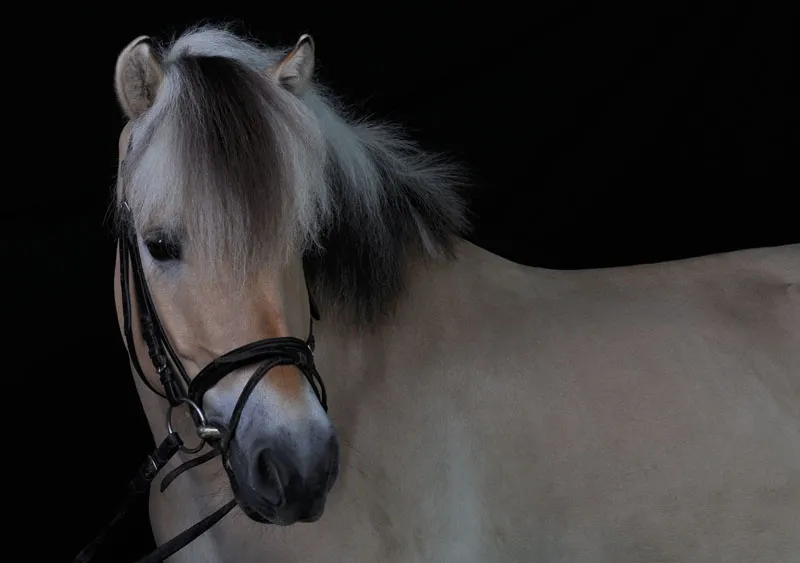
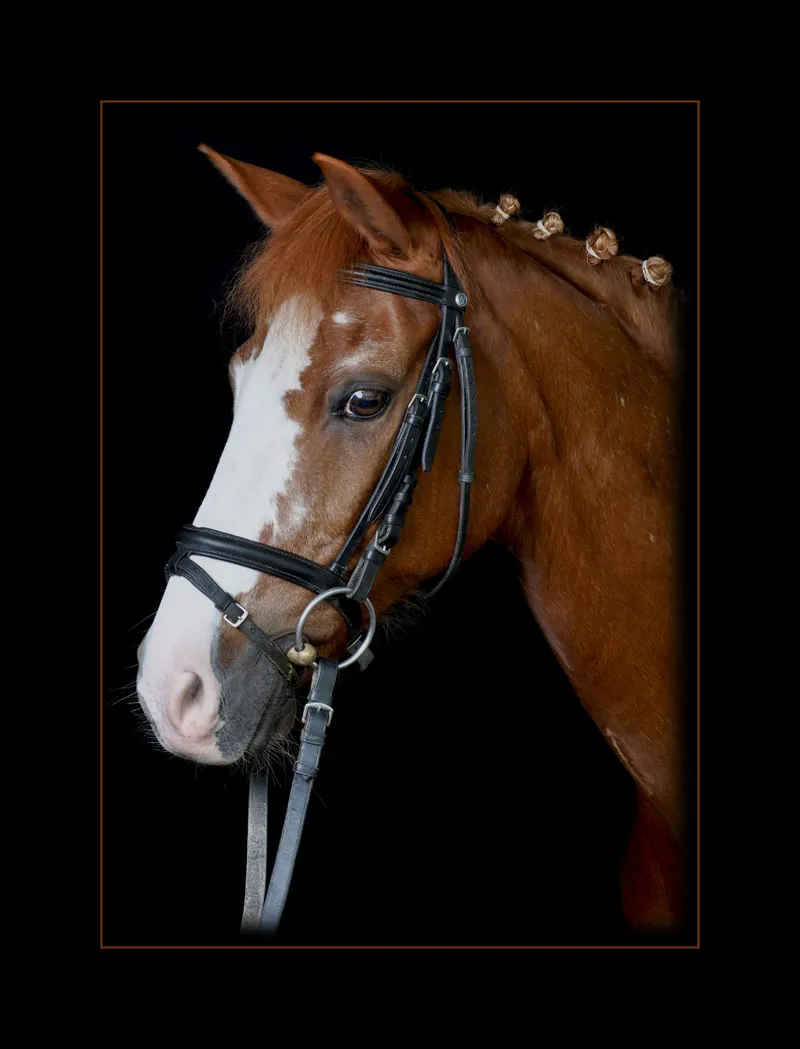
10. voice of the horses
I would like to say one more thing about being horse-friendly. Every horse person, and perhaps you as a photographer too, will develop your own philosophy as to which equestrian sports are really good and which may harm the horse. The fact is, in every sport there are things that are certainly not horse-friendly and should therefore not be supported. But ask about experiences and opinions on the subject of education and training in other areas. No matter whether we are talking about animals or children. I just want to say that I am not a fan of all equestrian sports and always try to form my own opinion despite all the talk. The camera often comes to my aid, as I can then see things that would otherwise have remained hidden from me. Captured in the picture, I can later see very clearly on the monitor whether the rider has given soft or hard aids and the horse's expression is also captured and often speaks volumes. This brings us to the next question: can a horse look happy or unhappy? Form your own opinion on the subject of horses and equestrian sport and the way these animals are treated. Don't be overly judgmental, but be fair to the horse. As a photographer, you have a particularly valuable voice. So don't praise those who don't deserve praise ... There is an interesting book on this subject: "Finger in the Wound". It touches on what I am talking about. For example, I would never photograph a military race that puts the horse's health at risk with every jump, or publish a picture of a horse and rider falling. At most as a cautionary tale. What I'm saying is that dogs and cats have a voice when they suffer pain, a horse does not. Support the equestrian sport that deserves it and not the one that is not horse-friendly. You make up your own mind about this, of course ...
A few days ago, while I was looking for reptiles to photograph, it was said during a discussion that the photographer and the pet owner come at it from two different directions. The photographer only sees the aesthetics and the pet owner the welfare of the animal. I say to that: One must not exclude the other. We are only good animal photographers if the animal's welfare is our top priority. Aesthetics can only take second place and give us pleasure if we know that our subject was doing well when we took the picture!
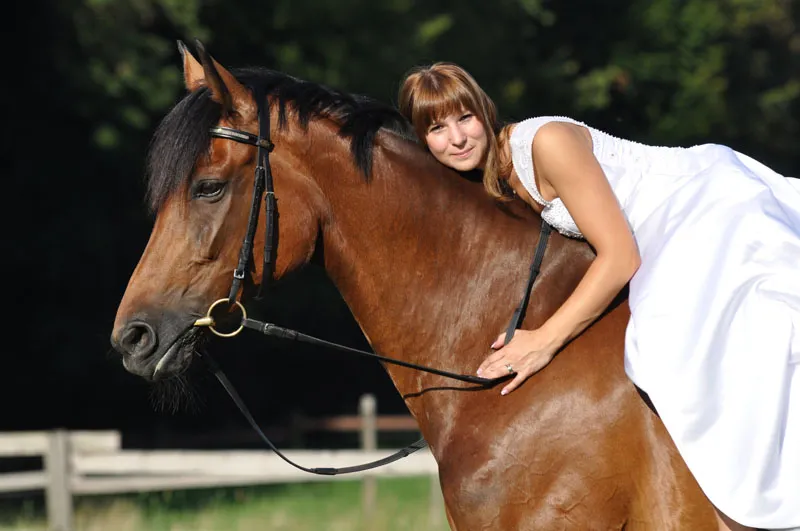
A final word: If you would like to photograph horses and don't know anyone who owns a horse, then just go for it: write a note with your request and simply ask at a riding stable near you whether you can put it on the notice board. Search the internet for riding stables and clubs in your area or perhaps look for a breeder and ask if you can take a few photos of their animals free of charge. You might get a no, but you might also be lucky! Or maybe you see a great horse on a ride while you're out for a walk? Just ask the owner if you can photograph it once.
I hope that despite the declaration of love for the horse, the tutorial has helped you and given you some inspiration.
Nicole Schick
www.tierfotografie-mit-herz.de
